Amsterdam‘s Red Light District is one of the most popular neighbourhoods in the city. It’s not a secret that the area is famous for sex, but the district is also filled with history, art, and vibrant culture. Sadly, so many people think of the area as nothing more than a novelty attraction. But if you look beyond the neon red lights, it’s not hard to see why this area of town has drawn people in for ages, for more than just the girls in the window. This stunning canal district is home to some of the city’s most beautiful (and ancient) architecture, infamous “coffee shops” and fabulous cafes. Come with us on this self-guided tour of Amsterdam’s Red Light District to discover what this place is really all about.

- Is the Red Light District Safe?
- When to do the Tour?
- Red Lights After Covid?
- History of the Red Light District
- What Not to do in the Red Light District
- Grimburgwal
- Oudezijds Voorburgwal
- House at the Three Canals
- Agnietenkapel
- Dollebegijnensteeg
- Trompettersteeg
- Sex Worker Monument
- The Oude Kerk
- Geldersekade
- Amsterdam's Chinatown
- Fo Guang Shan He Hua Temple
- Waag
- Nieuwmarkt
- Bloedstraat
- Kloveniersburgwal
- Dutch East India Company
- Oude Doelenstraat
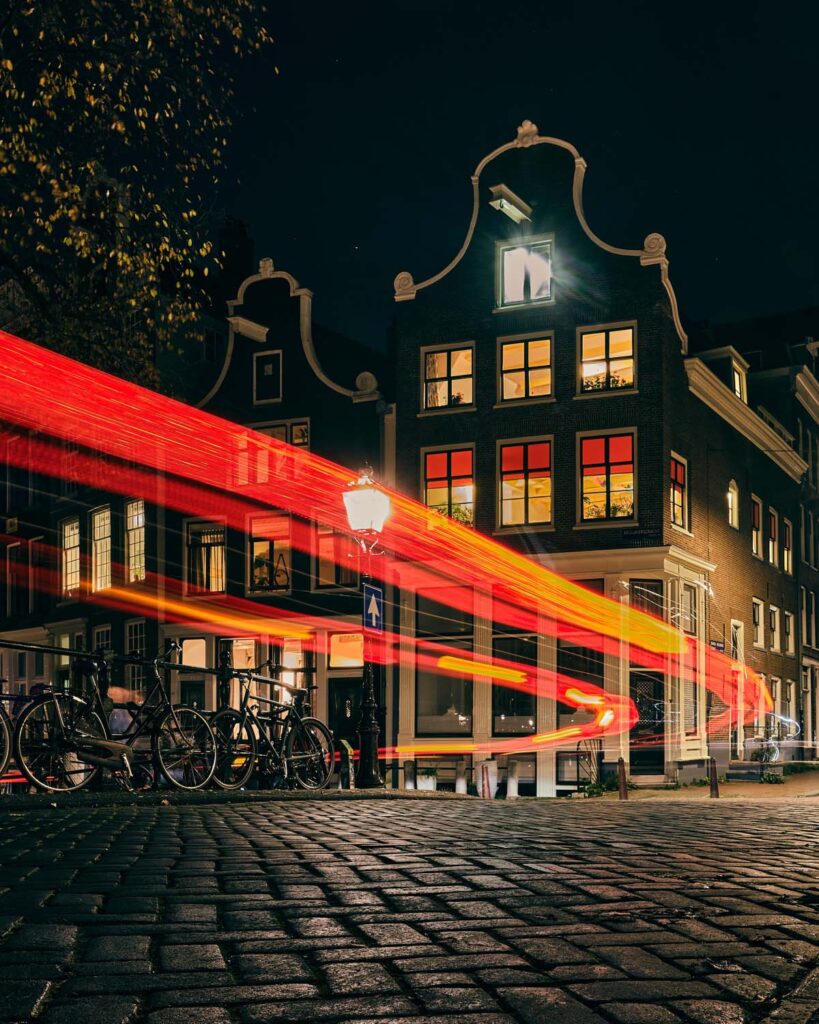
Is the Red Light District Safe?
Thanks to government regulations on prostitution, the trade is now legal inside sanctioned brothels. These laws helped shadier businesses flee the area. In the 1980s, the Red Light District got a bad rap for being a hub of illegal hard drugs. But after a large-scale police crackdown, the area almost immediately changed. In fact, today the Red Light District is actually one of the safest parts of Amsterdam since policemen and bodyguards patrol the streets at night.
When to do the Tour?
You can easily make an entire half-day out of the tour. I would say to start at midday as the architecture is great to explore during the day. But as night creeps in, you’ll get to be amazed at the beautiful neon lights that transform the canals into almost another world. Anytime after 11 pm is when the real action occurs. So if you’d rather avoid that, you can quickly head back to your hotel once the sun goes down. This tour does not go into details about procuring any sex workers in the Red Light District. This guide is focused on the history, architecture, art and culture that has developed out of the famed neighbourhood. That being said, sex work has been a huge part of the history of the area. Be advised that some information presented in the tour will go into this adult subject matter.
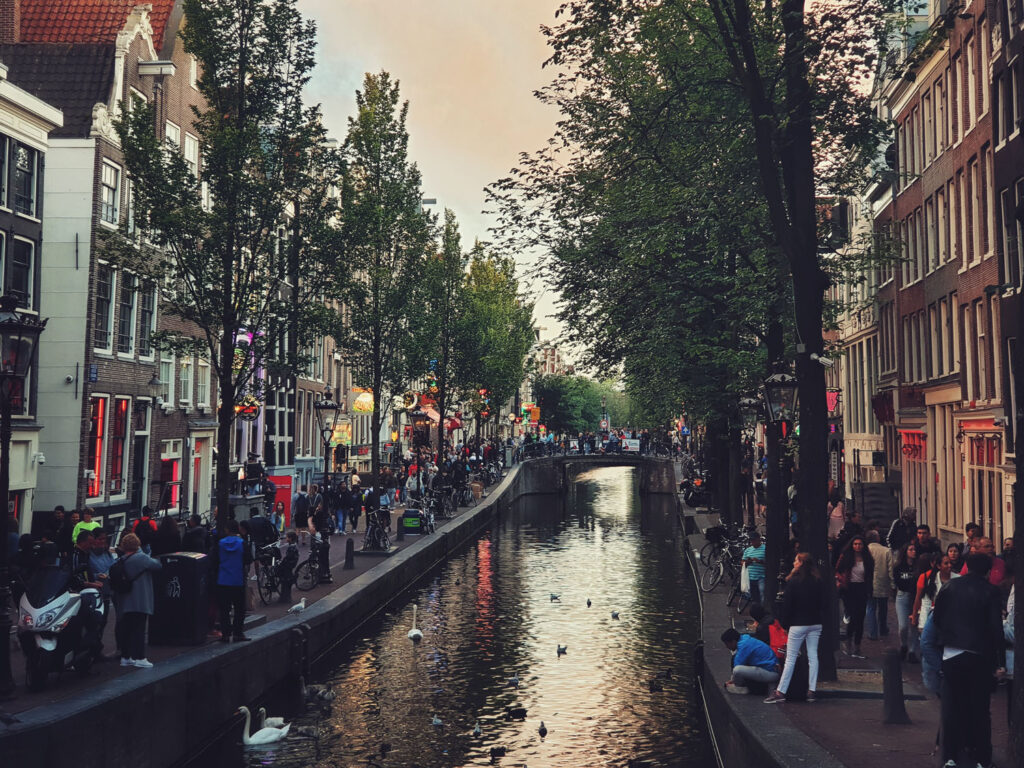
Red Lights After Covid?
On the heels of Covid-19, the city council of Amsterdam set out to do something they had been trying to do for ages. And that was to move the Red Light District out of the city centre. The council claimed the move was “necessary to change the type of tourists attracted to Amsterdam.”
But this idea was roundly rejected by the actual sex workers. Their prime location in the Red Light District meant that finding customers was an easy task. A move further out into the off-skirts of town would mean less foot traffic and fewer customers. Sex workers need to see a high turnover of customers each night to make a decent living wage. A reduction in the constant stream of people greatly affects their bottom line. Currently, the proposal has passed, but only time will tell to see if the customer and business will indeed move out of the area or not.
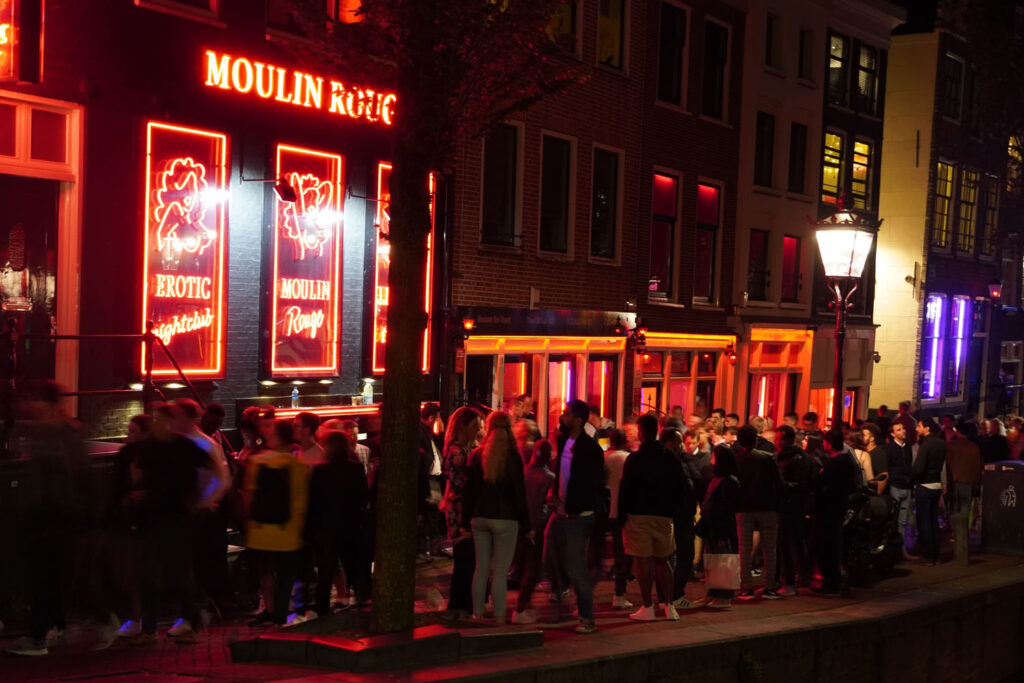
History of the Red Light District
The area of town that is now dubbed the Red Light District is officially named De Wallen. “De Wallen” was the medieval city center of Amsterdam. Where other medieval city centres have been transformed into pristine, curated living museums, De Wallen is still full of life and urban action! The bustling Damrak, which today is one of the city’s busiest streets, was once a large water-filled canal. It was the largest of all the channels, dug out around 1270. The Damrak was constructed as a large harbour for incoming ships. The surrounding canals had defensive walls built around them to protect the goods being imported into the Damrak. This is where the name De Wallen comes from, meaning “the walls.”
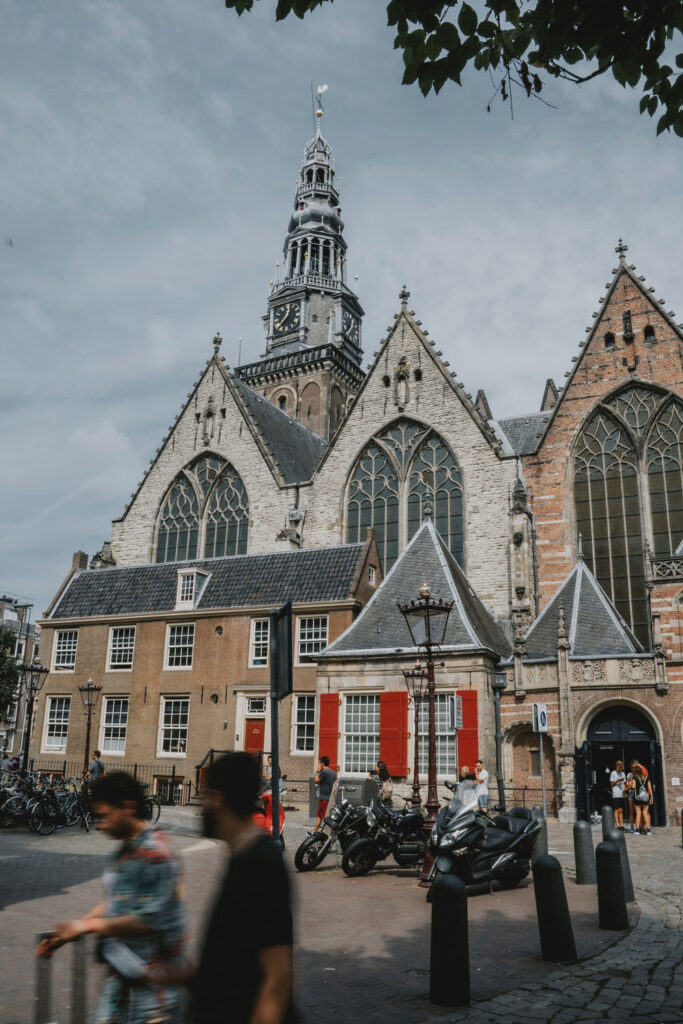
The Dawn of the Red Light District
Historically because of proximity to the harbour, the area has always been a hub for prostitution. Sailors coming into port looking for an evening of action while away from home. But as the trade began to grow in popularity, the church finally started to take notice. The church started its campaign to remove such activity from their city as early as the 15th century. In 1413 the law stated that after a prostitute received two warnings for her actions, she would be buried alive as punishment for her illicit affairs. Other penalties included cutting off a women’s ear for sleeping with any man who wasn’t her husband. Seeing a woman on the street with one ear was the scarlet letter of the time in Amsterdam.
Finally, in 1578 they had all sex workers were banned from working. But like anything which gets banned, the trade simply when underground. For years, this continued, with prostitutes soliciting customers on the street or inside pubs and inns. While sex work was still technically illegal, it was often ignored and loosely tolerated by the authorities.
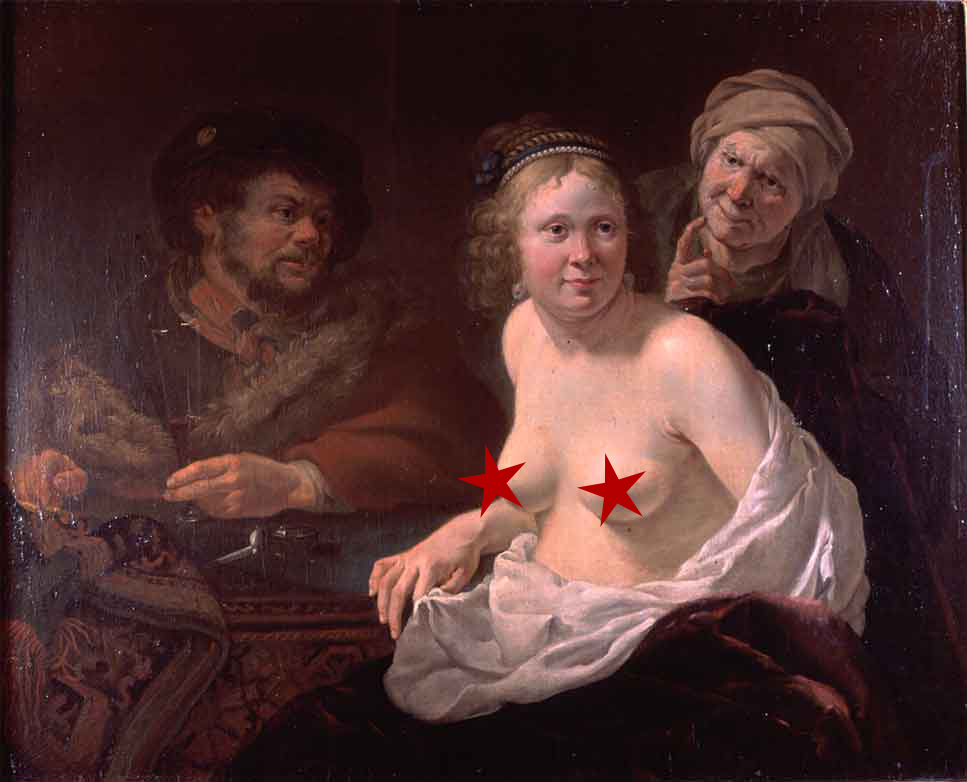
Gambling Houses Make Room for Brothels
By the 18th century, sex workers were commonly found working inside Amsterdam’s famous gambling houses located in De Wallen. Most of the men who visited these gambling houses were actually aristocrats. Looking to cut loose and escape the trappings of their tight-laced life. But when the sex workers would bring the men back to their filthy homes, the men were less than impressed. The gambling houses saw this as an opportunity. They offered to build luxurious brothel rooms for the women inside their establishments. This was thought to be a great idea as it kept the men close at hand. Should they finish up and want to return to the gambling tables. The authorities agreed to the arrangement but let’s face it, they were most likely paid off to look the other way.
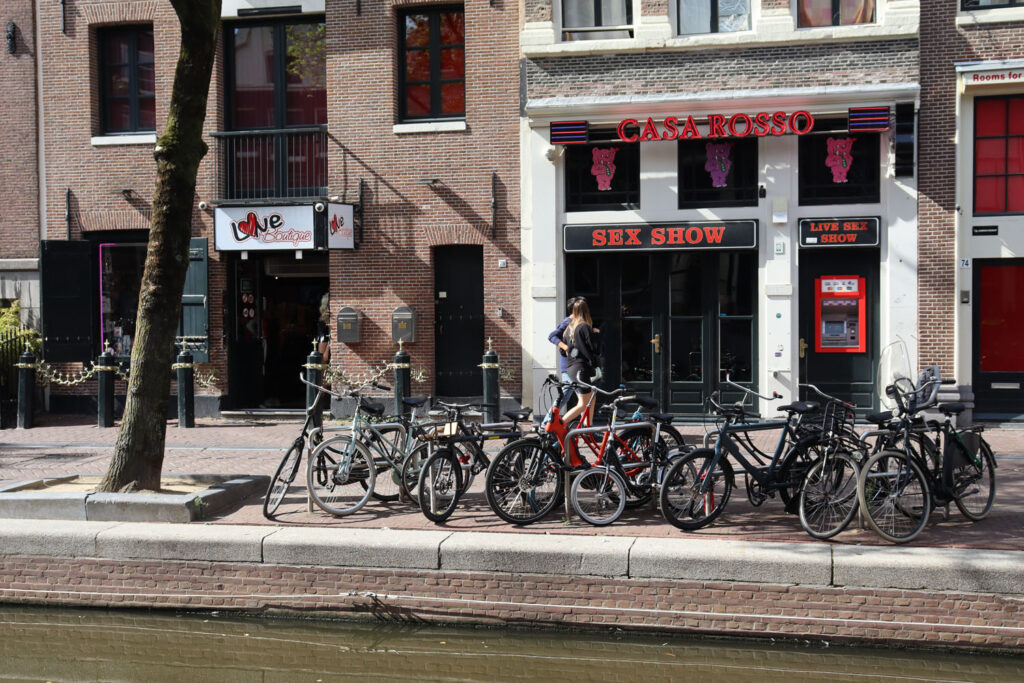
The Napoleonic Health Crusade
By 1811 the ban on street prostitution was officially lifted thanks in part to Napoleon. French soldiers were frequently stationed in Amsterdam and, of course, would find themselves at the brothels. But before there were National health clinics, diseases like syphilis ran rampant through the brothels. Infecting any visiting soldiers. As there was no cure for syphilis at the time, soldiers would find themselves dying from a casual night out. Knowing there was no stopping such “interactions” between the soldiers and sex workers, and seeing how many good men he was losing, Napoleon’s government thought up a solution. They began doing health checks, bringing doctors inside the brothels. They ensured better sanitary regulations to help prevent the spread of disease. If you were deemed healthy, sex workers were given a red card to carry with them. This indicated to anyone that they were permitted to work and were disease-free.
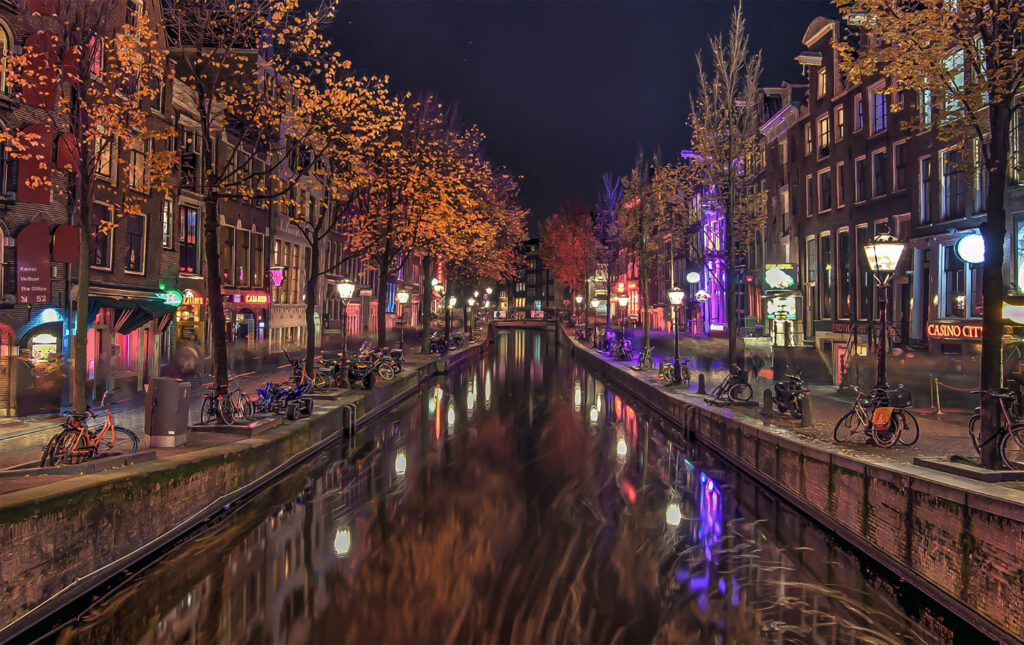
The Name ‘Red Light District’
The name ‘Red Light District’ began to be used in the 19th-century when brothel-owners began to use red gas lamps as an informal way to alert potential customers to their businesses. Today, they have done away with the idea of gas lamps but replaced them with the prominent use of red neon lights. Come nighttime, these lights flood the streets and canals and give the area its iconic appearance.
Red Lights in the 21st Century
You might be asking or just curious to know, “is sex work legal in the 21st century?” Paid sex between adults (18+) is now legalized in the Netherlands. So long as it occurs inside an approved “window” or gentleman’s club. Any sex worker is free to refuse service to anyone. Customers are often given a laundry list of rules to follow when engaging in these sexual activities. It’s imperative to discuss that while much of this work might be legal, illegal sex trafficking is still an ongoing issue. We will have the chance to learn more about that later, as many institutions in the Red Light District are passionate about ending these criminal actions and advocating for the safety and rights of consensual sex workers.
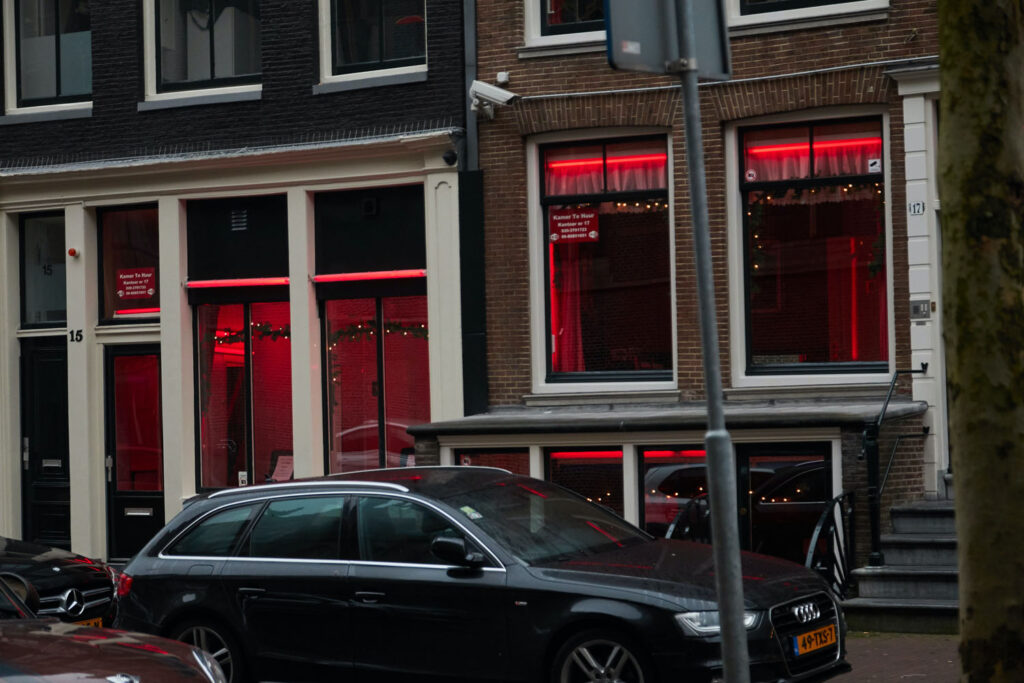
What Not to do in the Red Light District
During the day, you won’t need to worry about these tips but come the neighbourhood’s transformation during the evening it’s best to follow these pointers;
- NEVER take pictures of the women in the windows. It is forbidden to do so, and some workers are known to keep a cup of pee on hand to throw at such “law” breakers. Picture taking breaks the anonimity of these women and can expose them to real safety problems. There are places where you can snap a photo of the area without risking the exposure of any women’s safety
- While the area is much safer than it used to be, I would still advise you to leave your valuables back at all the hotel
- The area is super touristy, and with tourist crowds come pickpockets. Be so be sure to keep an eye on your bags, keep money concealed and avoid open purses
- Anyone visiting on their own is a target, so be sure to walk with friends or join a tour group
- Like anywhere in Amsterdam, don’t accept drugs from anyone on the street
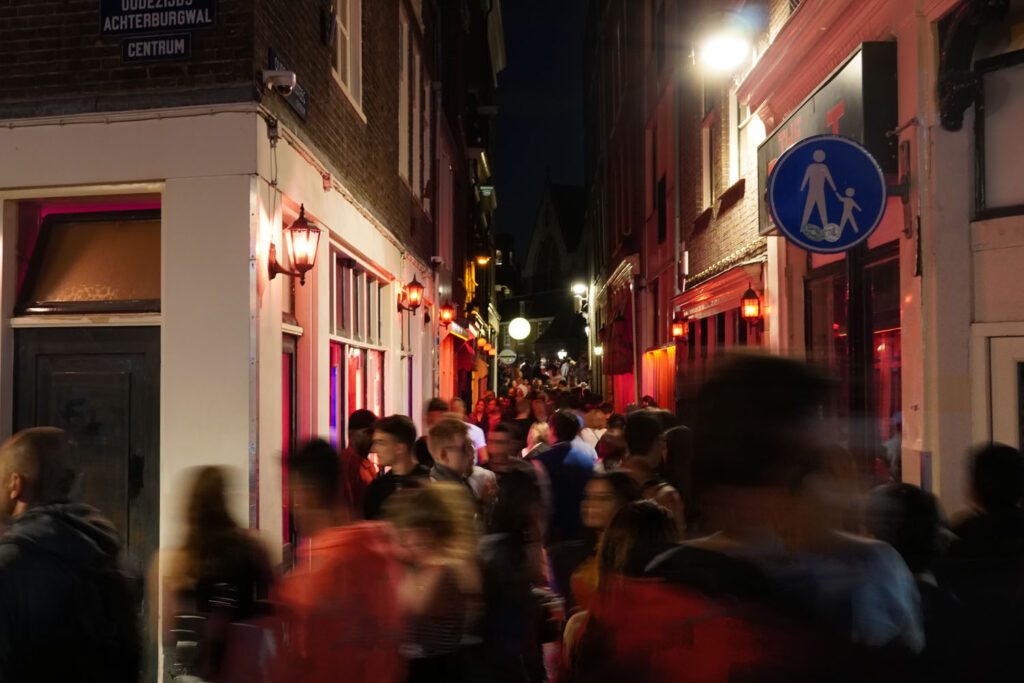
Grimburgwal
We start our tour on the outskirts of the Red Light District, along the Grimburgwal. The Grimburgwal marks the entrance to the Medieval centre of Amsterdam. This narrow watery passageway connects the great Oudezijds Voorburgwal to the Amstel river via the Rokin canal. The name “Grimburgwal” comes from the word “grim,” which means “muddy ditch” and “burgwal” which means earthen wall. This part of the city was home to this large earthen wall dug out along the muddy waters used to protect the medieval city. The wall was destroyed in 1384 during the city’s expansion. The Grimburgwal remained the city’s southern canal border until 1425 when the canal belt began to be constructed. It’s a small, almost forgettable canal today, but its rich history is something to take note of.
Oudezijds Voorburgwal
The Grimburgwal ends at the Sleutelbrug bridge, which looks out over the entrance to the Oudezijds Voorburgwal canal. The Oudezijds Voorburgwal means “old city walls,” as this area was where the defensive ramparts continued around the old medieval city. The canal was originally nothing more than a little creek but was dug out to create this large waterway in the 14th century. As the canal was one of the first large expansions, it is where we can find some of the oldest buildings in Amsterdam. Despite the fact that today the area is known for its illicit activities, in the middle ages, the area was where you could find a large number of monasteries, churches and religious institutions.
During the 17th century, many wealthy Catholic merchants made this part of the city their home. Back then, the area was nicknamed the “Velvet defence-canal“. Sort of a dig at the rich merchants who lived here who were known for dressing in fancy velvet clothing.

House at the Three Canals
At the intersection of the Oudezijds, the Achterburgwal and the Grimburgwal, we find the Huis Aan De Drie Grachten or House on the Three Canals. Name because it is located at this meeting point of these three famous waterways. This house is so fantastical, designed in high Dutch Renaissance style. I especially love the large leaded glass window and set-in brick arches above them. The charming red wooden shutters making it so classical Dutch looking. The house was originally two separate lots built around 1610!
The house was designed for bricklayer Claes Adriaensz van Delft. Seeing as it was made for a bricklayer it is only appropriate that the bricks on this house are among the most impressive parts of the entire building. During the 1930s, a bookstore was opened in the house. Inside, the various bookshelves hid behind them, secret compartments where Jewish people on the run from the Germans could hide. These hidden compartments were only discovered in 2005 during renovations to the building. Adding to the already illustrious history of the building.
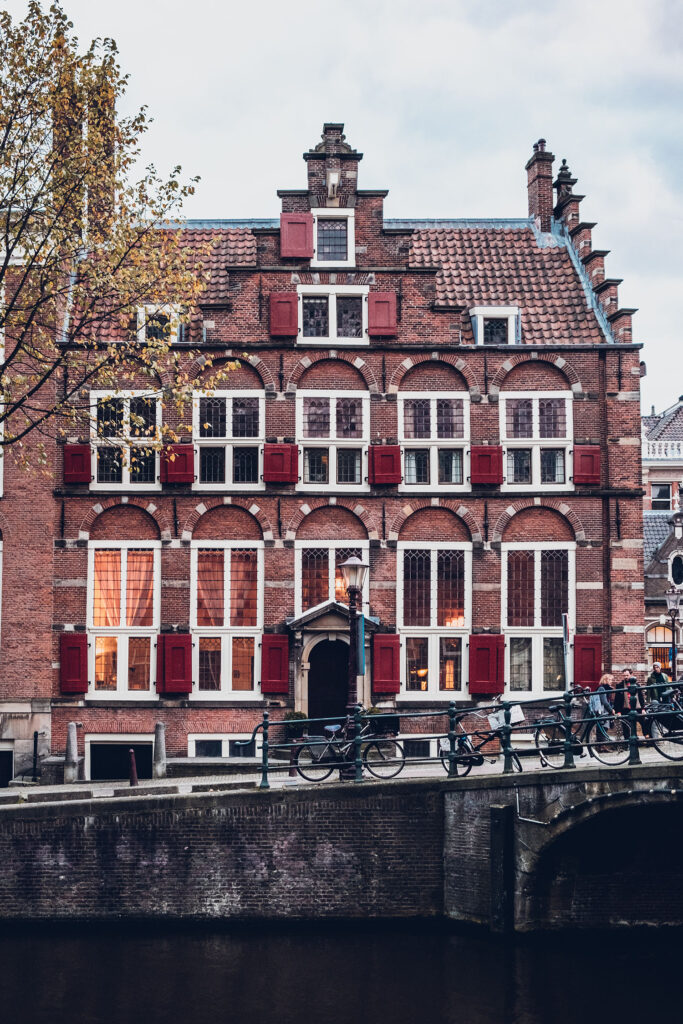
Agnietenkapel
Behind this grand arched entrance, is the doorway into the old Agnietenkapel, also known as the Chapel of the Convent of Saint Agnes. This is one of the oldest structures in the city, dating back to 1470. In the 15th century, the area along the southern half of Oudezijds Voorburgwal canal was called the stille zijde or the “quiet side.” This so-called peaceful part of town became popular with religious institutions looking for a monastic place to build their home. Away from the hustle and bustle of the raucous trade center. Very ironic today that all these churches are now located in what would be considered the most unholy neighbourhoods, the Red Light District.
Athenaeum Illustre
In 1578, when the Catholic city government was deposed in favour of the Protestant one, all Catholic churches and monasteries were demolished. This was called the Alteratie, or the “alternative.” But the Agnietenkapel was thought to be too beautiful to be destroyed. Instead, in 1631 it was converted into the Athenaeum Illustre. The Athenaeum Illustre, or Amsterdamse Atheneum, was a city-sponsored ‘illustrious school.’ An Athenaeum Illustre was neither a university nor just a school. It fell somewhere between where it would teach at an academic level, but there were no degrees given out. In the 17th century, each province was only allowed one official university, and Holland already had a university at Leiden. It wasn’t until 1815 that it was recognized as an official academic institution where diplomas could be given out. Leading to its transformation into the University of Amsterdam.
Church Gate
The Agnietenpoort or Church Gate is fantastically carved with so many ornaments placed along the archway. You can see why they decided to preserve it when it changed hands from the church. On the top, set into a large shield is the Amsterdam coat of arms. The coat of arms of Amsterdam consists of a red shield (here just plain stone) with three silver Saint Andrew’s Crosses down the middle highlighted by a black pale. The black pale symbolizes the Amstel River, while the three crosses represent the three dangers of Old Amsterdam: fire, floods and the Black Death. St. Andrew is the patron saint of Amsterdam as he is the patron saint of fisherman as the city was originally just a small fishing village.
Surrounding the coat of arms is typical Vredeman de Vries motifs. Hans Vredeman de Vries was a Dutch Renaissance architect best known for his publication in 1583 on garden designs. Inside this book were many drawings of floral ornamentations that have since been referenced ever since on buildings all over the city. A large cartouche frames the emblem with the year 1631 below and a roaring lion on top. The Dutch Republic Lion was the badge of the Union of Utrecht and a precursor of the current coat of arms of the Kingdom of the Netherlands. You’ll find lion symbols all over the city to represent this ancient heraldry.
Stadsbank van Lening
Pawnshops have truly been around forever! Proof positive of this fact is the old Municipal Pawnshop found along the canal. This building was established in Amsterdam in 1616. It was created as a municipal charity to protect poor people from shady loan sharks. These loan sharks would lend out money at a sky-high interest rate that made it impossible to ever pay back and get out of debt. The Amsterdam Municipal Pawnshop was started as a not-for-profit city bank that still operates today! It is considered the oldest bank in Amsterdam and one of the oldest banks in the world!
Above the doorway, you’ll find the city coat of arms topped by the Emperor’s crown. In gold lettering, along the pediment over the doorway, is a poem in Dutch. It reads, “Have you neither money nor property, pass this door. Have you the last, and do you miss the first, come to me. Give pledge, I give you money, why should I guarantee you? Or isn’t it enough that you live off mine? But if you return your pledge, you must take care in time. That my principal will return with interest. I help you and me and show it to the investigators. Of my secrets, the grave of forgotten usurers.“
The Prinsenhof
Another holy institution located along the Oudezijds Voorburgwal was the St. Cecilia Monastery. The original church was built in the early 15th century but after the Alteratie, the Catholic institution was converted into the city’s Prinsenhof in 1581. It was named the ‘Prinsenhof‘ after Prince William of Orange. In the late 16th century, the prince of Orange was the ruler of the Netherlands and would often use the building as his primary residence. It was later used as the Admiralty in the 17th century.
Prinsenhof as City Hall
In 1808 King Louis Bonaparte pulled the old switcharoo and wanted to convert the beautiful Dam City Hall into his Royal Palace. This meant the city needed to find a new location for its city hall. Seeing as the Prinsenhof was little used at this time, it was selected as their new City Hall. The building was used as accommodation for visiting dignitaries, mayors and, of course, city council meetings. When the city council moved in, the building saw a huge change in the architecture to suit its new function.
Amsterdam School Style
The new style of architecture which came out of the building of the new city hall was called, “Amsterdam School Style.” Like all variations of Dutch architecture, it heavily featured brickwork. The use of bricks is the primary building material in Amsterdam is due to the fact that the city’s access to clay. Clay is found in abundance around the rivers which encircle the city. Amsterdam School structures are also characterized by a rounded appearance, as demonstrated here by the curved facade bowing out towards the canal. The style also tended to favour decorative masonry, wrought iron accents, spires and ‘ladder’ windows. The style is slightly reminiscent of the Art Deco design aesthetic but with a Dutch interpretation. The decorative masonry here features large artistic pillars along the first floor. They depict men and women as symbols correlating to administrative virtues such as simplicity, courage, and diligence.
City Hall Public Urinal
Across from Oudezijds Voorburgwal #195 is a small brick and stone cylindrical structure which is actually a public urinal! A urinal probably seems like a very strange thing to make a point to visit. But this urinal has become an actual National Monument. It was built in 1926 and renovated for the new City hall. The urinal was designed to fit into the same uniform Amsterdam school style as the City Hall. Right on top of the urinal entrance, you’ll find another sculpture designed by artist Hildo Krop. This sculpture matches the same sculptures on the pillars outside the City Hall. If nature calls, men can still use the rudimentary bathroom today!
Oudezijds Voorburgwal #187
The Dutch Classical black brick building at #187 has a very interesting gable design, specifically around the ornate claw pieces. The house was built in 1663 for an American tobacco trader. We can tell the house was designed for a merchant working in the Americas because of the imagery featured in the claw pieces. We can see sculptures of the merchant’s enslaved Africans holding tobacco leaves. Above them are pictured personifications of indigenous workers carrying large harvest baskets.
Amsterdam’s Architecture of Colonial Exploitation
Many parallels can be drawn between America’s colonization and the enslavement of the African people to the Netherlands’ own dark colonial past. Everyone knows that the “Dutch Golden Age” was the city’s great boom in the 17th century brought about by its free and tolerant society and its enormous trading empire. With the creation of the Dutch East India Company, the Netherlands had an empire of ships that roamed the coastlines of Asia and Africa.
But it wasn’t just spice and silks they brought home. They also colonized countries and robbed them of their natural resources. And although the Dutch didn’t bring slaves back to their home country, the colonies suffered through a period of around 200 years of slavery until it was abolished in 1863. While houses like this and other images of slavery are tough to observe, it’s essential to understand and accept this period of Amsterdam’s history. You can learn a lot more about Amsterdam’s Architecture of Colonial Exploitation in this great article!
Oudezijds Voorburgwal #136
The house on Oudezijds Voorburgwal #136 was first built in the 16th century. Above the doorway, there is an iconic wooden relief featuring the famous navy officer Admiral Cornelis Tromp. Cornelis Maartenszoon Tromp lived in Amsterdam but never at this particular residence. In fact, the relief wasn’t installed until well after his death. The house was purchased by trader Jan Pranger who had a great reverence for Cornelis Tromp as a fellow sea traveller.
Tromp can be seen in his heroic pose, his hand resting on a large globe above a scrolled nautical chart in the background. The relief was hidden for years when the house was converted into a printing shop that covered up the old plaque. In the 1990s, when the house was being refurbished, the old emblem was released, and they went about restoring the brightly painted colours to their former glory. The house basement was converted into a sex shop in 1980 but today the house serves as the headquarters for the green energy initiative in Amsterdam.
Dollebegijnensteeg
While the majority of the canals and streets we’ve seen so far bear no resemblance to anything you’d imagine the Red Light District to look like, Dollebegijnensteeg indeed does. Even during the day, this area screams sex work. Mainly due to the graffiti paintings of a scantily clad woman along the walls. This alley is a hub for window prostitution. During the day, the windows remain dark. But you can peer inside and see their stools or chairs, empty beds and bare interiors.
In the evening, women rent out these windows from the brothel owner on a nightly basis. They will turn their red lights on to display the fact they are open for service. If you see a window at night with the shade drawn, this means they are currently “servicing” a client. Visiting during the day is a great way to peek inside this world without it seeming too overwhelming. At night the atmosphere in these narrow alleyways can feel intimidating even for those just there to observe.
Bulldog Coffeeshop
The Bulldog Coffeeshop is a famous landmark in the neighbourhood as it is the oldest “coffee shop” in Amsterdam. It was established in 1974 as a secret “speakeasy” for soft drugs. Despite multiple raids over the years, eventually, the city began to tolerate the sale of these drugs. Many people think marijuana is legal in Amsterdam, and surprisingly that’s not the case. But it is generally accepted, even by the police, who look the other way. The original location is worth visiting as you can discover more about the history of cannabis in Amsterdam inside.
Even if you don’t partake in the consumption, you can’t visit Amsterdam without seeing what these “coffee shops” are all about. Plus, this location has a full menu with food and drink options that don’t contain any drugs. I myself don’t partake but still had a blast checking them out and seeing what a comfortable, friendly atmosphere I was greeted with inside.
Trompettersteeg
Almost so narrow it’s barely noticeable is Trompettersteeg. Located right beside Bulldog Coffee Shop. Trompettersteeg or Trumpets Alley is the narrowest alley in the city. Historically this alley is where some of the highest-priced sex workers display themselves in their windows. But in recent years, it has become one of the most photographed places in the Red Light District. But not for the reasons you might expect. Especially when everyone has a camera on their phone, banning photos in the entire Red Light District has become very challenging. But taking a picture of these women at work is really degrading. It makes them feel like they are in a zoo and not human beings. It also is a huge safety issue as most sex workers prefer to remain anonymous for a variety of reasons.
#No F*cking Photos
To help detract from this photo-taking frenzy a local artist was enlisted to create a series of murals. These were aimed to address the subject and help educate people on the dangers of a simple selfie. The project was called “Respect the Ladies.” But the iconic hashtag #NoF*ckingPhotos was used to really hammer the message across. The project is the first thing you see upon entering the alley. It urges tourists to respect sex workers and not take any photos of them. Instead, get a shot of the mural before entering if you must document the moment. Then, quickly put your phone away. This idea of giving people a spot to take their photos without infringing on the rights and privacy of the sex workers seems to have helped out for the time being. Just another example of how street art can be so influential.
Bronze breastplate sculpture
Hiding right outside the largest church in Amsterdam is a small, flat sculpture laid into the ground. You might even step right over it if you don’t know what you’re looking for. I’ve marked it on the map, so you know exactly where to go. Right under the shadow of the church lies a bronze sculpture depicting a hand cupping a nude breast. The statue was placed here in 1993 by an anonymous artist. The breastplates sculpture is thought to pay homage to the hard-working women when working in the Red Light District. There are actually several bronze sculptures around Amsterdam, all of which were placed there without permission. Like the predecessor to Banksy.
Despite the city council raging against these illegally placed sculptures, the public appreciation for them was wildly popular. The story is that when the city was about to have the statues removed, the artist came forward in private and revealed themselves to the city council alone. After that, the sculptures were deemed to be approved, and they were all left in place. One can only wonder what kind of artists would have that kind of pull over the city council. Some people even suspect it was Queen Beatrix herself. But for now, it remains a mystery.
Sex Worker Monument
Continuing around the back of the church, you will find a minature bronze statue that goes by the name “Belle.” Belle also represents all sex workers. She was installed by the nearby Prostitute Information Centre. Even in the shadow of the church, Belle stands in the nude, tall and proud. Ashamed of nothing. Fierce and defiant. Below her name is the inscription, “Respect sex workers all over the world.“
The Oude Kerk
The crowing glory of the Oudezijds Voorburgwal canal is the grand Oude Kerk. The Oude Kerk or “Old Church” is named as such because is the oldest religious institution in the city. The first wooden part of the structure was constructed here in 1213! Originally the church was named St. Nicolas Church after the patron saint of the city.
The area they selected for the church was a sold mound in the otherwise marshy settlement. This allowed the church to grow in size without requiring much additional foundation work. Today the church sprawls out over 36,000 sq ft. Each generation of Amsterdam’s religious elite seemed to have added their own personal touch in its expansion. In the 14th century, the side aisle was lengthened, and the great medieval wooden vaults were installed. These remain to this day are the oldest medieval wooden vault in all of Europe. The vaults were made out of great Estonian oak planks. Some of the plants were stained in various colours to look like paintings on the ceiling. Bands of florals surround each part of the vault with golden stars decorating the keystones. These vaults are still thought to provide some of the best acoustics even amongst the more modern churches.
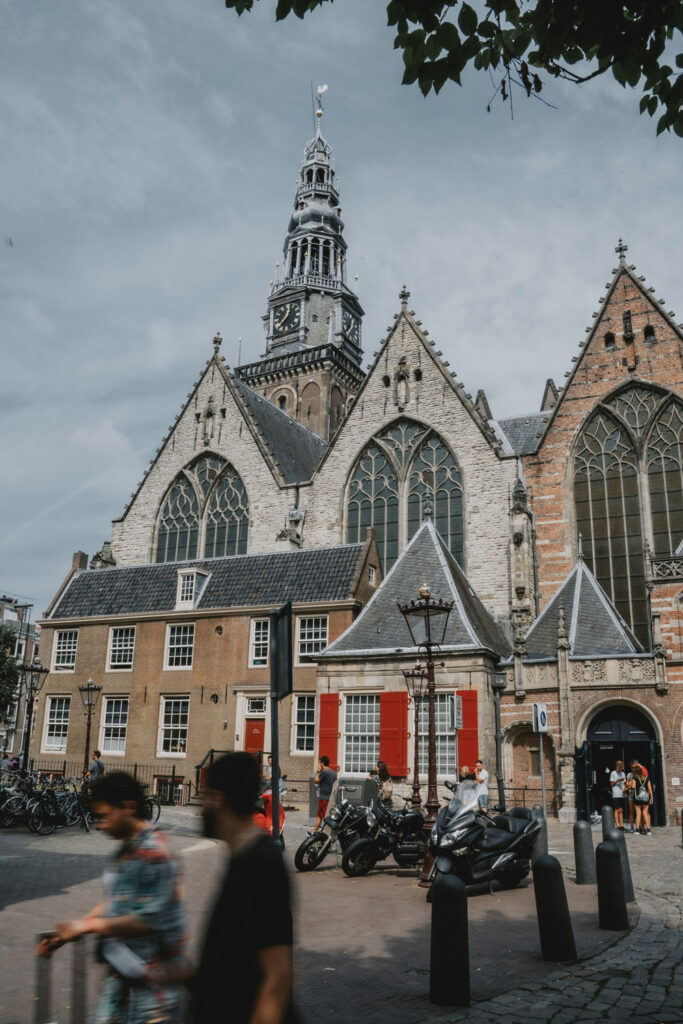
Miracle of Amsterdam
In the 14th century, the church was the site of the “Miracle of Amsterdam.” One day, a dying man accepted the sacramental bread during communion. But after ingesting it, he began to vomit it up in a fit of pain. When the priests threw the vomit into the fire, the bread did not burn, and the act was proclaimed a miracle. Even stranger than the miracle itself was the fact that the vomitted bread was preserved in a relic chest and kept inside the church. Sadly their miracle relic was one of the many items which disappeared during the Alterie.
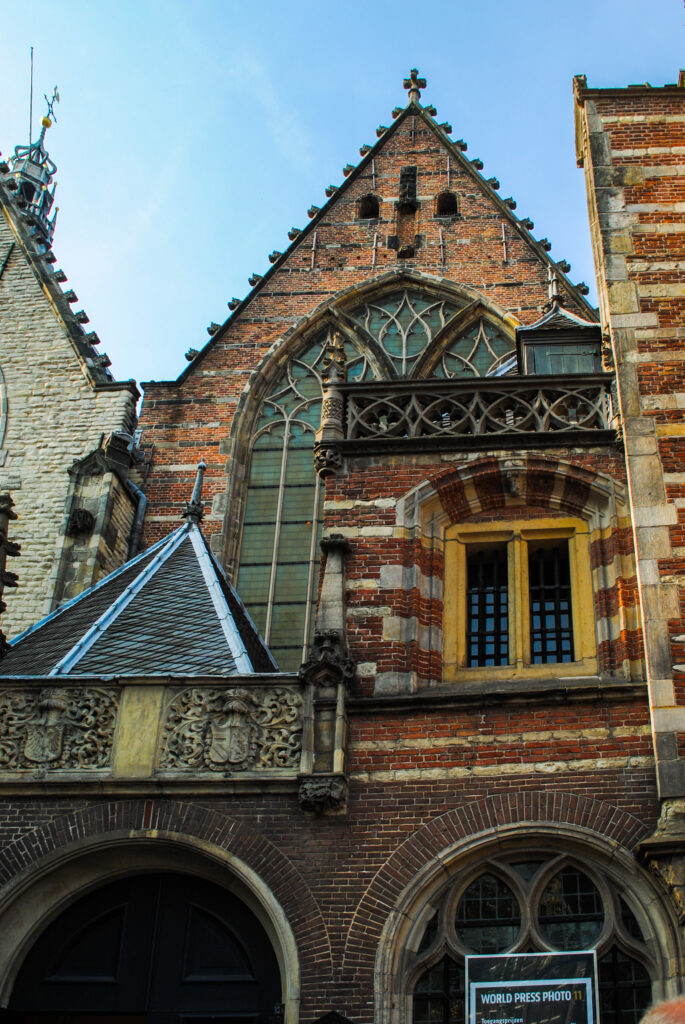
Stained Glass
In the 15th century, a north and south transept were added to change the floorplan of the church into a cross shape. The beautiful large windows inside the church were installed in 1406 and were once covered in vibrant stained glass. More and more windows were added over the years, totalling 33 large-scale artfully made scenes. Sadly during the great fire of 1536 and the gunpowder explosion in 1654, all of these original windows were destroyed.
Most of the windows are now plain glass replacements but, beginning in the 20th century, these windows began to be restored. Using paintings, drawings and historical architectural plans, the church museum started to create modern interpretations of the ancient windows. There were created by artist Joep Nicolas. The windows depict various biblical stories, such as the Parable of the Prodigal Son and the story of baby Moses. But they also commissioned some modern, secular scenes as well. Inside the Memorial window are depictions of WWII victims who were killed during the Nazi occupation. The Libration window also commemorates the Netherlands’ liberation from the German and Japanese occupiers.
Oude Kerk & the Alterie
After the Catholic Reformation in Amsterdam during the late 16th century, the church was looted and defaced on multiple occasions. This stripped the church of much of its original decorations save for a few paintings. The thieves couldn’t reach them as they were installed high up under the vaults. After the Reformation, the church was used as a meeting house for the public. People would come here to escape the cold and the rain to gossip, sell their goods, and it was even used as a de-facto homeless shelter.

In the 17th century, the church was reconsecrated and been given a fresh coat of paint. New decorations were installed, including a new oak screen which referred to the desecration during Reformation. It states, “The prolonged misuse of God’s church, was here undone again in the year seventy-eight.”
Rembrandt & Oude Kerk
One of the most famous Dutch painters, Rembrandt himself, was a frequent visitor to the Oude Kerk. All of his children were baptized inside the temple, and it is one of the few original buildings left in Amsterdam where the painter roamed the halls. His wife, Saskia van Uylenburgh was buried here in 1642 inside the Holy Sepulchre. Another famous figure buried is naval hero Jacob van Heemskerck who was a central figure in Rembrandt’s masterpiece The Night Watch.
Today, the church is used as a contemporary art gallery where the ancient architecture is the backdrop for modern art. Entry into the church costs €12 for adults and €7 for students; children under 13 are free. On Sunday mornings, the church still opens its doors for worshippers for free but only for those serious about coming in to pray.
Prostitution Information Center
The perfect antithesis to visiting the Old Church is to pay a visit to the neighbouring Prostitution Information Center. The Prostitution Information Center or PIC for short, was established in 1994 by ex-sex worker Mariska Majoor. Sadly, Majoor became a sex worker at the young age of 16. But she took this hardship and turned it into the fire that fuelled her. She became a huge activist, fighting for the rights and legal protection of sex workers. In fact, she was instrumental in changing the Dutch laws regarding prostitution. Inside the Prostitute information center, you can learn more about the social conditions working in the sex industry. This centre doesn’t aim to glamourize the sector but rather be open and honest about all aspects of the work.
De Wallenwinkel
Right beside the PIC, you’ll find the Red Light District Store, also run by the PIC. The shop goes by the name De Wallenwinkel and inside you’ll find lots of books, maps, guides and more. The money spent inside the store helps support the health and wellbeing of all sex workers in De Wallen. Even if you just buy a little souvenir map of the area, it goes a long way to support the centre.
Oudezijds Voorburgwal 57
Across the bridge from the Oude Kerk at #57 is a gorgeous example of Amsterdam Renaissance architecture made by the famous architect Hendrick de Keyser. They call the house the De Gecroonde Raep. It features one of the finest examples of stepped gables in Amsterdam. With these gorgeous scalloped stone carvings above each step. The facade also features these beautiful brace arches above the windows with smallmasks set into the pediments. Iconic features of Keyser are the double pilasters with cartouches set in between the brick pillars.
Ons’ Lieve Heer op Solder (Our Lord in the Attic Museum)
Hidden behind an otherwise simple brick facade is an example of a “schiller” or “clandestine church.” After the Reformation, Catholics needed to practise their religion undercover. A few old houses on the canal were converted into these secret churches. This church went by the name Ons’ Lieve Heer op Solder (Our Lord in the Attic Museum). It was built by a Catholic merchant in 1663 who transformed his third-floor attic space into the beautiful yet cramped religious wonderland you find today. Personally, I adore the pink-painted balustrades and railings, such a unique touch.
Visiting the Museum
After Catholics could practice in public once more, the church was exposed and opened as a museum in 1888. This makes it the second oldest museum in Amsterdam. Today, it remains a museum visited by over 85,000 people annually. In addition to viewing the secret church, you can also tour the 17th-century merchant canal house interior. Tickets are €14 for adults and €7 for children and students.
Oudezijds Voorburgwal 18
House at #18 bears a striking (if not a simplified version) of the house saw a few doors down at #57. The curved arches above double pilasters are a clear sign of the work of Hendrick de Keyser. Above the third floor, there are face masks, but on the lower levels, we find lion masks. Above the stone gable is a relief depicting the legendary castle of Egmond aan den Hoef.
Brouwerij De Prael
If you need to take a break, one of the best places to grab some lunch and a beer is at the Brouwerij de Prael. Brouwerij De Prael is a Dutch microbrewery established in 2002 by Arno Kooy and Fer Kok. It is a beautiful local brewpub with over 3,000 different labels as well as its own microbrews. Here you can enjoy a tasting of 4 beers for €10,00 per person in the most enjoyable atmosphere!
Oudezijds Voorburgwal 14
The Het Wapen van Riga, at #14, is a 17th-century merchant’s house. In the center, we find relief of the coat of arms of the country of Riga. The original house was built for a wealthy merchant who was indeed from Riga and this emblem was a way of paying homage to his home. The lions are a powerful symbol of the city of Riga. Two golden lions on a grey plinth were thought to symbolizes the strong foundation of the city and the bravery of its citizens. You can also find two of Riga’s lion heads protruding off either side of the stone gable on the first floor.
Oudezijds Kolk
Walk over and stand on the old Armbrug bridge to look out over the Oudezijds Kolk. During the Middle Ages, most of the canals in Amsterdam looked more like this canal. The old canals didn’t feature any sidewalks or laneways as the primary mode of transport was solely boats. When the newer canals around the canal belt were built, the boom of horse-drawn carriages had taken over. These canals were built to feature roads for horses and eventually cars to travel along. This canal is one of the last remains medieval canals in Amsterdam and a gem to treasure.
Weeping Tower of Amsterdam
At the end of the Oudezijds Kolk canal, you will find the largest of the three remaining medieval city towers. It goes by the Weeping Tower of Amsterdam. The legend goes that the wives of the sailors who were off to sea would come up to the tower to wave their last goodbye. Tears obviously ensued, echoing down the canals. The life of a sailor was a tough one as storms, scurvy, war, and pirates were all things that a sailor would come up against at sea. And most of these wives knew that upon saying goodbye there was a good chance they would never return.
Geldersekade
After reaching the Weeping Tower, turn back down south along the Geldersekade canal. The Geldersekade canal was part of the original city moat, dugout at the end of the 15th century. This canal makes up the borders of Amsterdam’s Chinatown. Chinatown isn’t honestly the most appropriate name for the area, as many different Asian cultures and cuisines are represented here.
Amsterdam’s Chinatown
Amsterdam’s Chinatown is the oldest Chinese and Asian neighbourhood in Europe, dating back to 1910. The first Chinese immigrants came to the Netherlands in the 1900s as sailors and stockers on large Dutch steamships. These Chinese immigrants had a tough life. In the early 20th century are they were forced to stay inside tiny cramped boarding houses along the edge of the city. Many of these original boarding homes were located along Binnen Bantammerstraat. When the Chinese sailors were too old to work on the ships, they began selling peanut cookies on the streets to make any money. In 1928 the first Chinese restaurant opened up on Bantammerstraat. It was called Kong Hing, and it opened to huge fanfare. Famously, American singer and dancer Josephine Baker visited the restaurant several times. Her picture hung in the restaurant until it closed.
Chinatown Post WWII
After World War II, many Chinese immigrants were here illegally and couldn’t find work in most above-board establishments. This gave rise to opium dens and gambling houses in Chinatown. Sadly, opium gave rise to heroin which by 1980 was being sold on the streets in this part of town. Giving the area and subsequent Red Light District a notoriously dangerous reputation. During the HIV/AIDS crisis in 1985, the city council aimed to purge the city of these drugs which had really taken hold over the area. After these raids and crackdowns, the area began to flourish once more. Today is a fantastic place to come and enjoy Asian cuisine from a myriad of different countries.
Fo Guang Shan He Hua Temple
Turn right along Stormsteeg and walk along Zeedijk. Towards the southern end of the street, you’ll be remiss to pass by the majestic Fo Guang Shan He Hua Temple, the largest Zen Buddist temple in Amsterdam. In fact, it is the largest Buddist temple in all of Europe! Even though the building was designed by a Dutch architect, the ornaments and roof tiles were flown in from China to ensure the building felt authentic. Look closely along the roof to spot various animal sculptures representing the different symbols of the Chinese zodiac. You are free to enter the temple and admire the lavishly decorated interior. It is complete with a giant statue and shrine to the Avalokitesvara Bodhisattva.
Waag
At the end of Zeedijk street, the road opens up into a large public square. Centered in the square is what almost looks like a minature castle. This delightful building is the oldest secular buildings left in Amsterdam, having been constructed in 1488! The name of the building is the “Waag,” which means “weigh.” Over the years, the building has been used as the literal “weighing house” where goods brought in through the canal were weighed and then taxed based on those calculations. It was one of the most important places in Amsterdam in the medieval era as it was where the money came in! In fact, back in the 15th century, the Waag was built into the medieval city walls. Only through these red doors would you be able to center this part of the city.
The Guilds
The Waag also became the home office of various guilds who took up residency in the different towers. The entrance door on the corners of the building, which still stands today, are marked with stone carvings relating to each of these guilds. In fact, the surgeons guild commissioned a painting of their guildhall by none other than Rembrandt himself! Although you really wouldn’t recognize it immediately as the Waag, the image is set inside the guildhall.
In De Waag
If you’re interested in getting a peek inside, you can actually dine inside the old Waag building. They have transformed this space into a fantastic restaurant. Walking inside the doors, you are greeted by over 300 candles that float on the chandeliers and all around the room. It’s truly an inspiring space that makes for the perfect romantic evening out.
Nieuwmarkt
In the 17th century, the area around the gatehouse was filled in. This was when the Niewmarkt square was introduced. While the square was a social meeting point for locals throughout the years, one of the most historic memories embedded into the stones was during WWII. It was in this very square was where the Jewish population was rounded up by the Nazis. They were gathered here and then sent off to concentration camps. Most of whom would never return. Today, the square is still a hub of activity with street vendors out throughout the week. On Saturdays, there is a huge food market and on Sundays, you can find an antique and craft fair.
Bloedstraat
Just off of Nieumarket, take a walk down Bloedstraat. This wide alley is one of the areas in the district where you’ll find blue lights. Red lights in the community are used to denote cis-gendered female sex workers. While blue lights are used to indicate to the customers that the worker inside is a trans-woman.
Compared to the alleys on the other side of the canal, these streets are beautiful and replete with gorgeous Dutch architecture. This makes the fact that during the evening, these windows turn into brothels a true Jekyll and Hyde act. The name “Bloedstraat” translates to “blood street.” The story of the name comes from the fact that this area of town was once the old Friars Minor Monastery. Built in 1464, one of the Monks who lived here built a torture chamber in his room along the street. Rumour has it that inside his victims would be whipped long into the night, the blood spilling out of the doorways and onto the street.
Kloveniersburgwal
Head back to the Nieumarket and walk south until you reach the edge of the square. At the end of the square is the entrance to the Kloveniersburgwal canal. Kloveniersburgwal means “city wall of the Kloveniers.” The Kloeniers were the name for the municipal guards. It was the job of the guards to patrol the walls around the city. Always on the lookout for any incoming armies or intruders.
Dutch East India Company
Head back towards our starting point by crossing the Bushuissluis and turning onto Oude Hoogstraat. On the corner of Oude Hoogstraat and Kloveniersburgwal is the fantastical old Dutch East India Company building. In Dutch called the Oost-Indisch Huis. This was the former headquarters of the Dutch East India Company. The company was a conglomerate of various rival Dutch trading companies which all came together to form this monopoly.
The building was designed in 1602. Back then, it was the largest building the city had ever seen. The Oost-Indisch Huis building was multifunctional, serving simultaneously as a warehouse, administrative center, office and auction room. It was built in high Amsterdam Renaissance style. The elegant facade with that gorgeous red brickwork is so iconic of that period of Dutch architecture.
VOC as the First Company Logo
The company itself was so large it even has its own flag and military army. And it was the first corporation to even design a logo to represent it. The name in Dutch was the Vereenigde Oost-Indische Companie or VOC for short. They used this monogram with interlocking serif letters to form their insignia. The VOC insignia would be used on every piece of material the company owned and produced. This meant notepaper, ships, storage boxes and spice containers. It was also used on cannons, coins and battlements on the Spice Islands they colonized. All as a means of promoting their dominance over the trade industry. For the indigenous residents of these brutally conquered islands, the logo represented nothing but violence, death and danger.
While the VOC is today mainly thought of as a trading company that sold silks, spices and coffee, it is a little know fact that they also financed wars and built plantations all over their colonies. All in order to get cheap or slave labour to produce their spice plants to harvest and sell all over the world. While the building is an impressive and dominant feature of the canal, it is essential to remember how they amassed all this wealth.
Oude Doelenstraat
This brings us to the end of the tour. If you started the tour later in the day, the night would have crept over the neighbourhood by now. The red lights of the district start to turn come on and it’s incredible how just a few (well, alright, a few hundred) neon lights can transform the canals. From what was once a medieval-looking street corner is suddenly a sultry-looking brothel. If you’re interested in getting some pictures of the neon lights, you’re safe to do so along the Oudezijds Voorburgwal. This bridge is my favourite spot on the Oude Doelenstraat, where you have a view all down the canal. Standing here, you can get a wide shot of the neighbourhood and scenery without focusing on any one window in particular. Just remember, if you can see them, they can see you. And best not to risk taking the shot.
Another photo spot, if you’re interested in finding a great location, is in front of the Erotic Museum. Their museum front has a beautiful neon sign and elegant doorway where you can appropriately get a picture to mark your travels into the Red Light District. And without risking the exposure of any working woman in the area.
I hope you enjoyed this tour and learned that the Red Light District is so much more than just a novelty, sex-filled street. Instead, it’s a wonderful neighbourhood full of history, culture and fantastic architecture! Let me know in the comments if you have any questions regarding visiting the Red Light District for yourself!
Happy Travels, Adventurers!
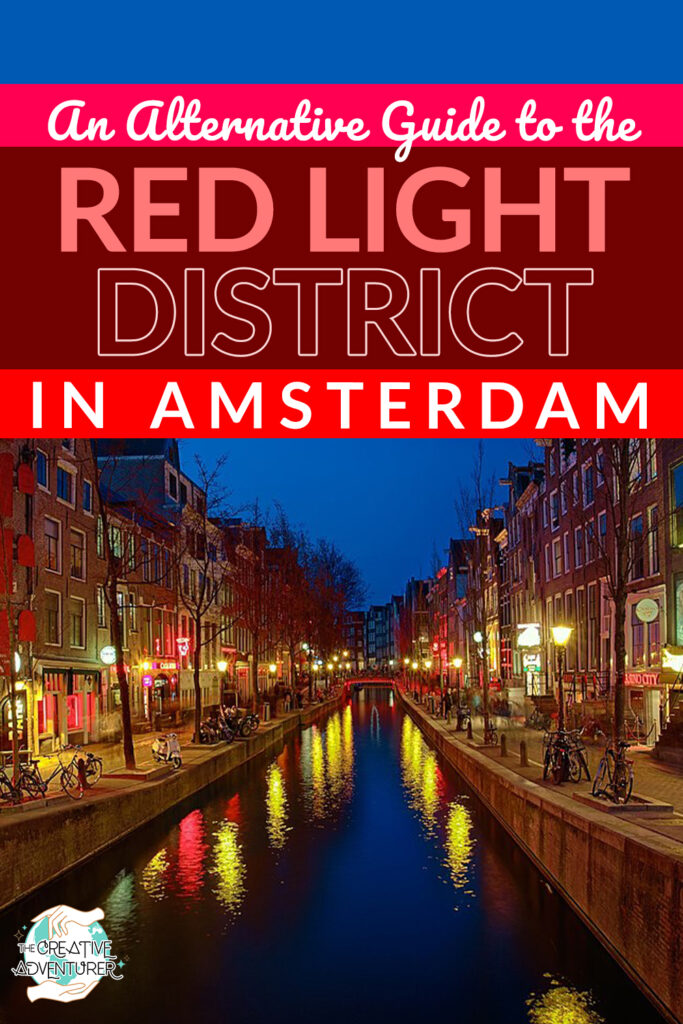
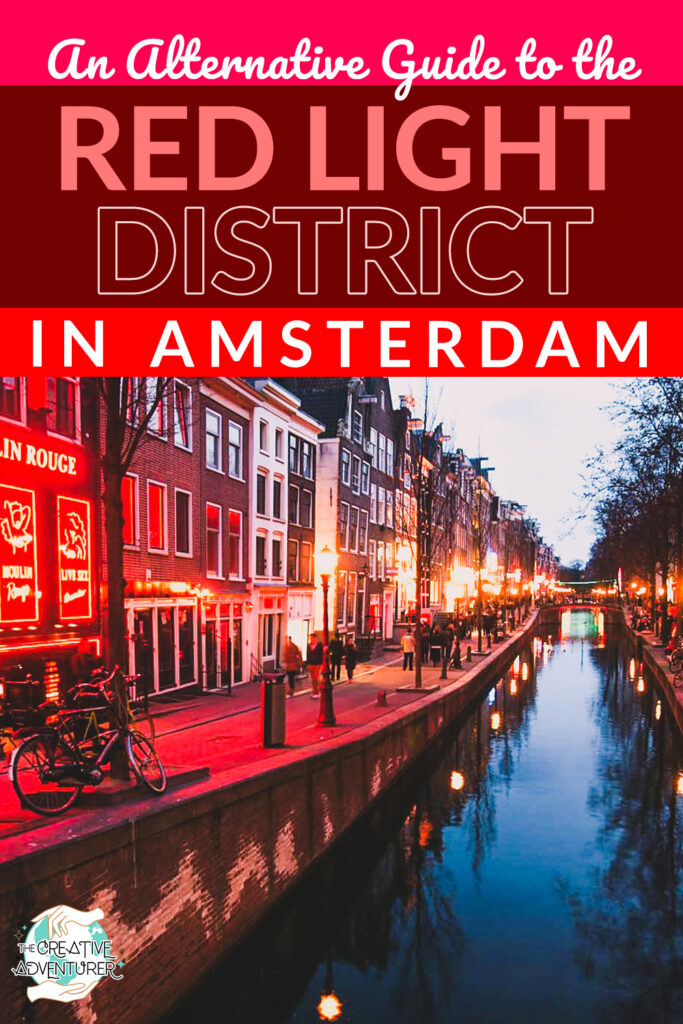
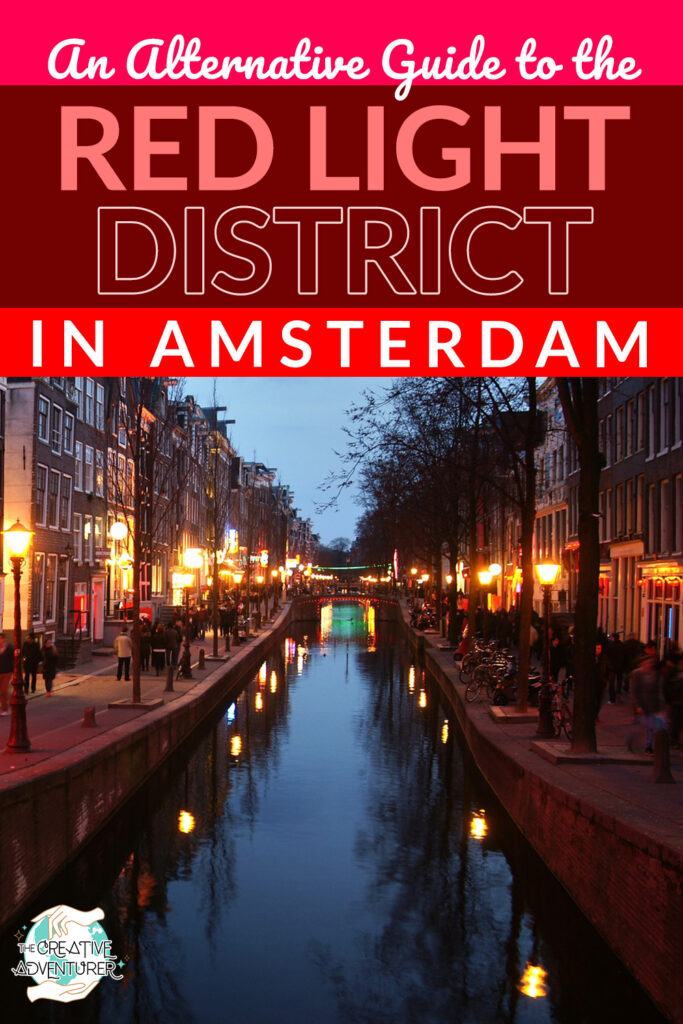
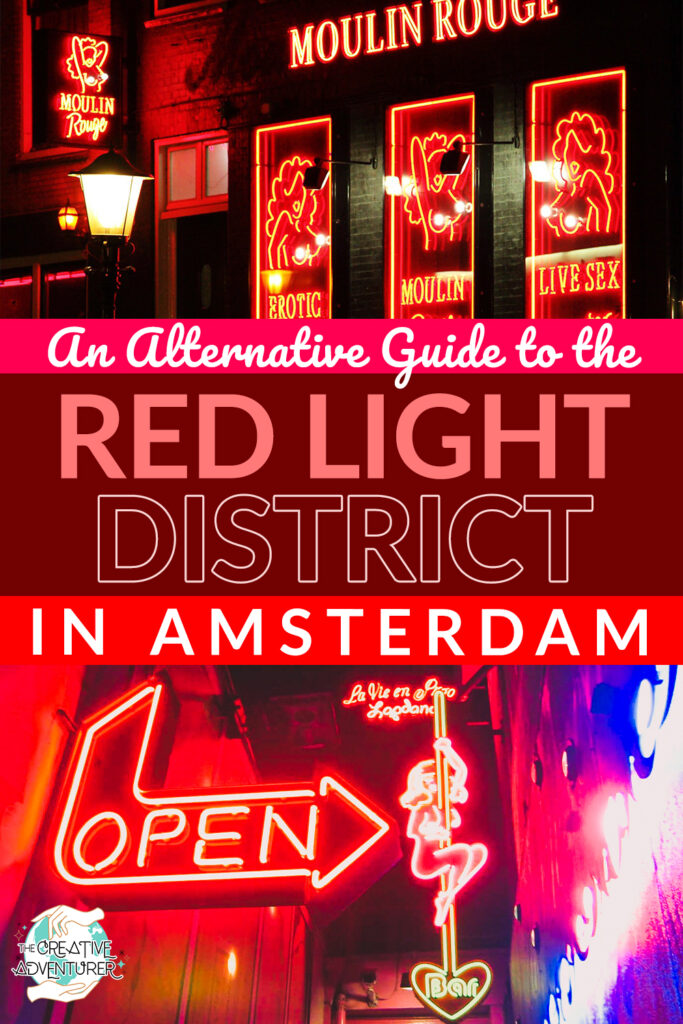
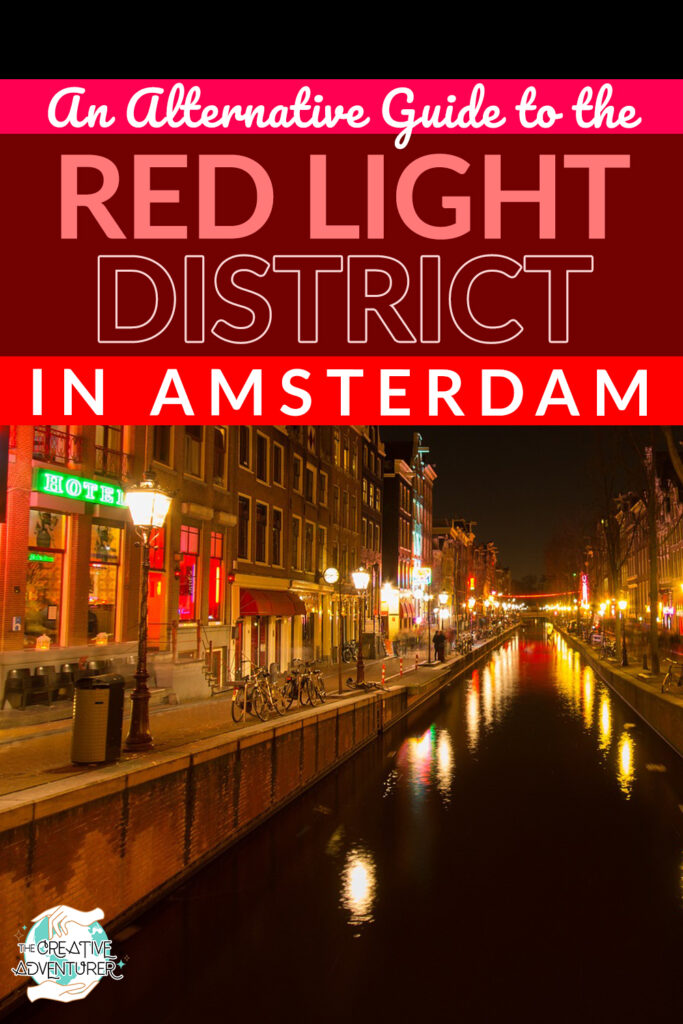
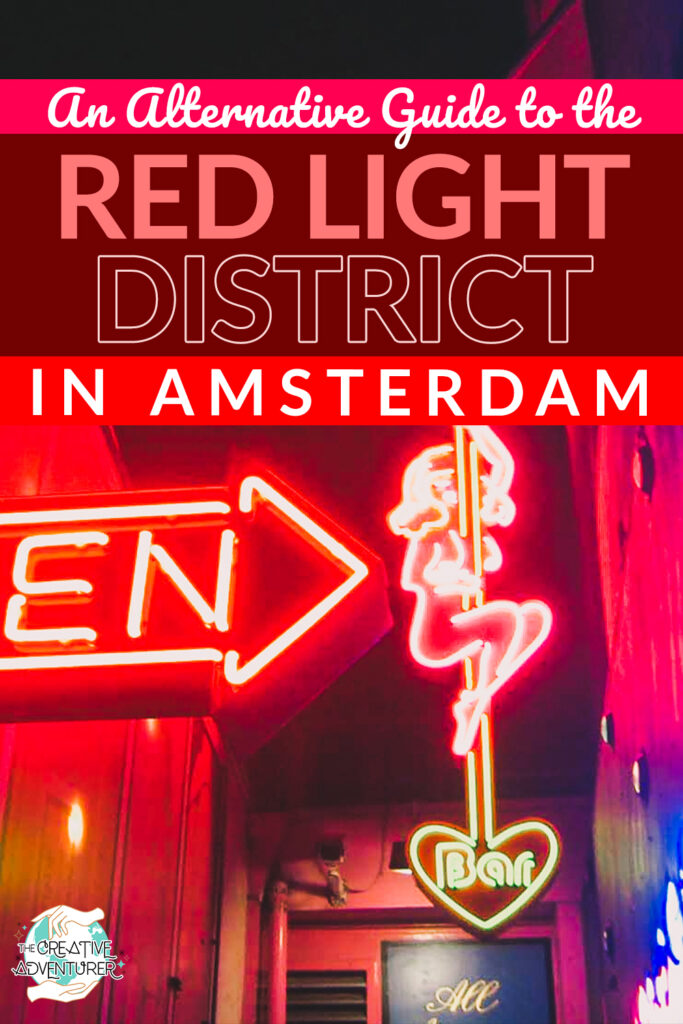


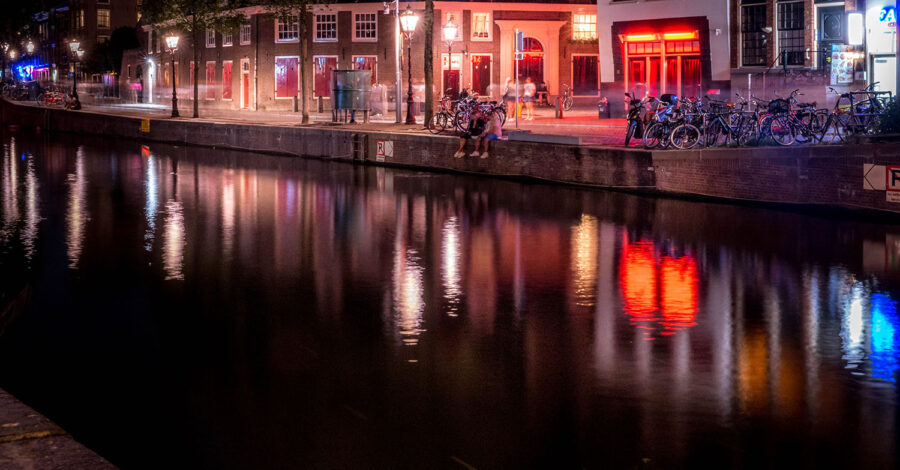
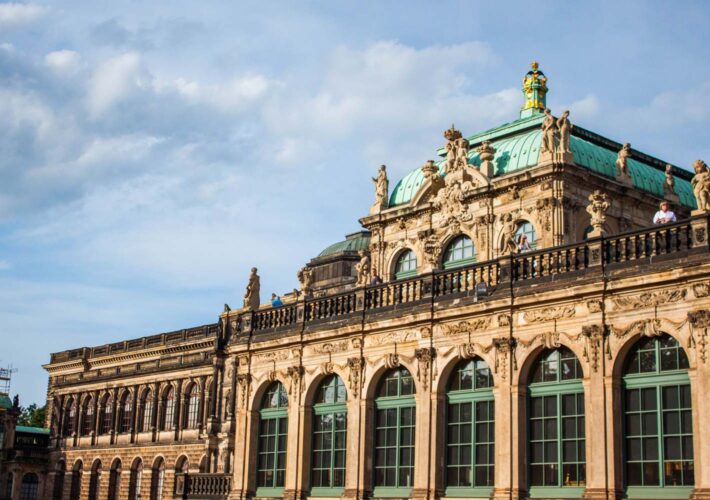
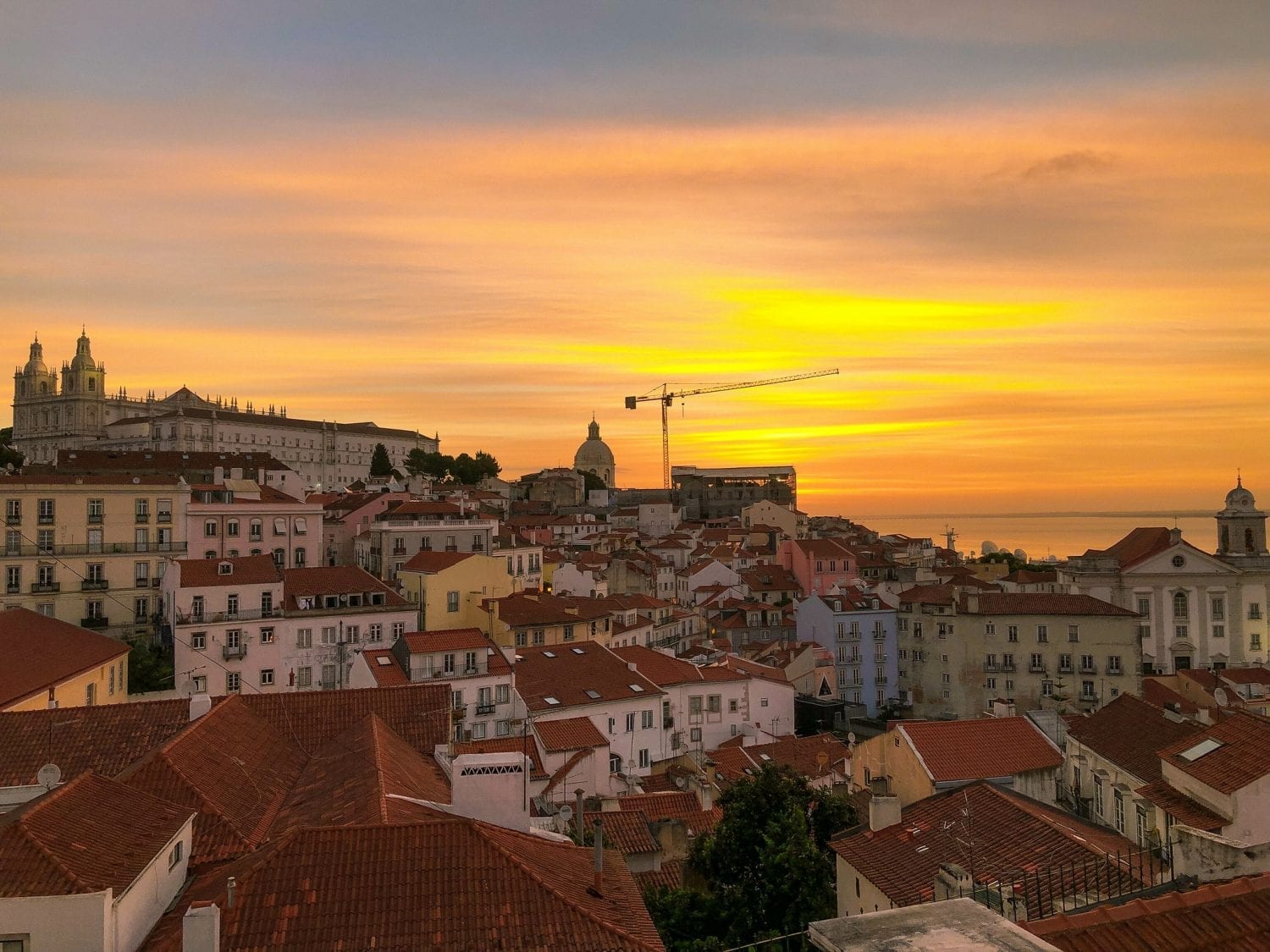
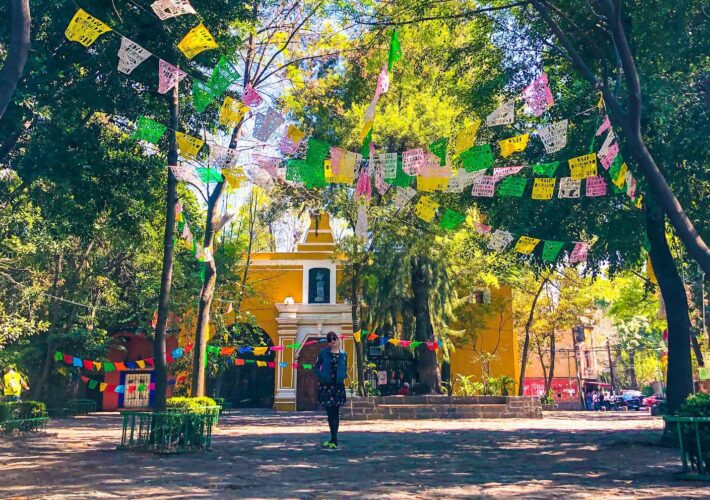
Leave a Comment